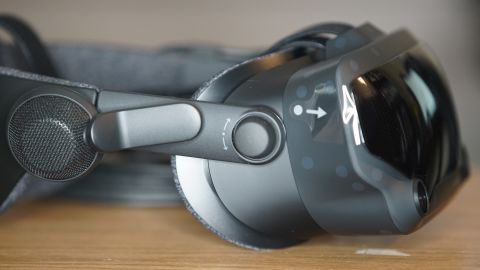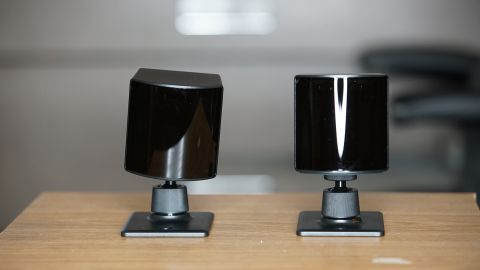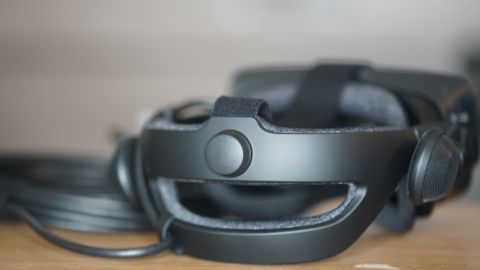From being a first-rate developer of contemporary gaming classics like Half-Life and Dota to establishing the industry’s biggest PC gaming storefront in Steam, Valve’s evolution has been jaw-dropping. Spending the last decade attempting to carve space within the hardware world, the Washington-based company most recently surprised many with the well-received Steam Deck. However, its virtual reality initiative is what properly set the stage for its successful run of devices after the failed Steam Machine consoles. Following its collaboration with HTC on the first-generation Vive VR headset, 2019 saw Valve produce and manufacture its own VR device with the Valve Index.
Available for $999, the Valve Index is built to be used on the company’s Steam platform. This means users have access to well over 200 games and productivity applications. PC gamers that are already deep in the Steam ecosystem — and have equally deep pockets — will find much to appreciate about the Valve Index, including the phenomenal headset itself as well as its wonderful controllers. Compared to other wired VR headsets, it simply doesn’t get better than this.
If you have the budget for it, the Valve Index is the best PC-based VR headset you can buy.
Outstanding design for both headset and controllers

Opening the all-black box reveals everything needed to get the Valve Index up and running in a seriously organized presentation. Both the headset and knuckle controllers are the first thing users will see on the first layer above the second compartment housing the dual trackers in addition to necessary cables. It all makes a wonderful first impression.
One of the most noticeable things about the Valve Index is how thoughtful the design is all around. Despite being heavier than the Meta Quest 2, PlayStation VR and HP Reverb G2, the even weight distribution on the headset doesn’t feel uncomfortable even during long play sessions. The plastic head harness for the Valve Index sits on top of the head comfortably thanks to plenty of padding from the face to the head. Similar to the PSVR, users fasten the Index through a dial, though there’s also a front strap to tighten the headset itself securely on the face. On the right side is another dial to position the screens closer or away from the eyes. Finally, there’s a focal point slider underneath the headset for added eye comfort as well. Again, all of these features make using the Valve Index an experience that always feels comfortable.
The faceplate is removable through magnets and houses a USB-A slot. This allows for things such as a third-party external fan which should keep the Valve Index from getting too hot, but that wasn’t much of a problem even during sessions that lasted well over an hour. As a nice touch during gameplay, there’s a button that opens Steam VR which provides an overlay for quickly switching games and other prompts like camera passthrough. While the Index has built-in audio, users can also plug in their own headphones or gaming headset by removing the face pad to reveal the 3.5 mm headset jack.
That level of comfort extends to the knuckle controllers too. After utilizing these dual controllers for a week, I can confidently say that these are the benchmark standard for VR input. Inserting palms into the cloth strap and pulling the drawstring below the controller makes these feel like an extension of your hands instead of just controllers. Unlike most VR input devices, the controller stays attached even when hands are completely open. To loosen the strap, all users have to do is press a button near the drawstring. Meanwhile, the knuckle controllers have internal batteries that are rechargeable through USB-C ports on the bottom. During playtest, they provided around five hours of gameplay and only needed less than a few hours to charge completely.
Meanwhile, each controller has a clickable thumbstick, a touchpad, two face buttons, a menu button, a trigger and 87 sensors for various types of tracking in addition to an accelerometer. Playing games like Half-Life: Alyx and Cooking Simulator VR was exceptional, controller-wise. It was definitely difficult going back to the Meta Quest 2 and PSVR controllers. VR controllers don’t get any better than this.
Great audio and visual presentation

Though the Valve Index’s per-eye LCD screen resolution is lower than the Meta Quest 2, HP Reverb G2 and HTC Vive Pro 2, it does offer the highest refresh rate which makes a huge difference in delivering the smoothest gameplay possible. The most popular games available don’t go higher than 120Hz, but there is experimental support for 144Hz provided users have a powerful enough desktop.
Despite having a relatively low 1440 x 1600 resolution per eye, games look incredible on the Valve Index. Colors are rich and vivid thanks to full RGB support and purposefully backlit LCDs. It’s also easy to catch every detail considering the field of view is around 130 degrees compared to the HP Reverb G2’s 114 degrees, Meta Quest 2’s 89 degrees and HTC Vive Pro 2’s 120 degrees. Whether you’re gaming or using a productivity app like Virtual Desktop, the Valve Index is a wonder to behold visually.
Playing games like Microsoft Flight Simulator, Half-Life: Alyx, and Medal of Honor: Above and Beyond was a fantastic experience on the Index. Considering Half-Life: Alyx was developed by Valve with the Index in mind, it makes sense as to why this game not only looks but plays the best on the headset. From the opening scene in the City 13 apartment to the more horror-filled underground portions with little to no lighting, this game is an absolute blast on the Index. No wonder Valve Index owners get Half-Life: Alyx for free when they purchase the headset. Playing the modern benchmark for single-player VR experiences on ultra settings at 144Hz mode is face-melting. Other games with the ability to be played at 144Hz are Beat Saber and Space Pirate Trainer. Though the difference wasn’t entirely noticeable compared to other headsets, the experience was better.
Virtual Desktop looked crisp on the Valve Index and also performed well. Playing non-VR games like Forza Horizon 5, Halo: Infinite and Teenage Mutant Ninja Turtles: Shredder’s Revenge or watching movies didn’t come with a hint of slowdown on the headset.
Buyers can use their own headphones or use the off-ear headphones that come with the Valve Index. Be mindful that the audio experience of the built-in headphones is just as good as its technological sibling the HP Reverb G2. Games like Half-Life: Alyx and Medal of Honor: Above and Beyond were more immersive experiences due to how well designed the headphones are. Like the Reverb G2, they can be pulled close or pushed away from the ears, with volume levels that are controlled from the overlay menu or Windows sound settings. The Valve Index audio package also includes a microphone which allows for easy communication during multiplayer rounds of Population:ONE — or any Zoom calls you might be taking in-between them.

As mentioned previously, Half-Life: Alyx comes free with the purchase of a Valve Index and currently proves why VR is such a powerful platform for gaming. Then again, users are going to want to play something else once they get through its 15 to 20-hour single player campaign. Steam has well over 200 virtual reality games available right now, and that’s not counting early access titles (which are usually extremely buggy at first).
Games like Beat Saber, Superhot VR, Five Nights at Freddy’s: Help Wanted, Boneworks, Arizona Sunshine and more are all there on Steam. The headset also supports games with VR modes like Microsoft Flight Simulator, No Man’s Sky and Star Wars: Squadrons. The Virtual Desktop app — which lets you use any Windows app in a VR environment — costs $14.99, though it’s currently discounted to $10.49.
Unlike the HP Reverb G2, the Valve Index features superb support for Revive. This means that gamers upgrading from their Oculus Rift or Rift S can still play games in their Oculus library without any issues. Games like Medal of Honor: Above and Beyond and Asgard’s Wrath worked near perfectly on the Valve Index controllers even with the lack of a second trigger button.

For how technologically advanced the Valve Index is, the setup process for both the hardware and software seems a bit behind the times. On average, expect to take about 20 to 30 minutes to get started.
This long setup is partially due to the use of two required tracking devices that need to be positioned across from each other. That wouldn’t be a problem if they both didn’t have to be plugged directly into the wall — meaning that Valve Index users are going to need three free power outlets. Though tracking was never an issue when using the headset, it’s not noticeably better than the Meta Quest 2, which doesn’t require separate tracking devices.
Outside of that, the actual headset itself doesn’t require a separate processor which is a plus as it plugs directly into a DisplayPort and USB-A 3.0 port alongside your power outlet. At a minimum level, the Valve Index requires a powerful enough gaming PC with 8GB of RAM, an NVIDIA GeForce GTX 970 or AMD RX480 graphics card and a dual-core CPU. To run Half-Life Alyx, users are going to need at least an Intel i5-7500 or Ryzen 5 1600 CPU, 12GB of RAM and GTX 1060 or RX 580 with at least 6GB of VRAM.
Setting up the Valve Index software is a pain though. There isn’t a passthrough guardian feature (which lets you see your real-life surroundings with the headset on) or the ability to make floor measurements like on the Meta Quest 2. During setup, users have to create a boundary and have to look at the desktop monitor. It seems a bit counter-productive as having to manually set height measurements for tracking.
Once everything is set up, the user experience on the Valve Index isn’t problematic at all. It’s just getting to that point that’s frustrating.

Valve initially made the Index available to purchase in parts (such as a headset-only option) at cheaper prices, but those are all sold out. Therefore, the only package users can currently purchase is the $999 edition that comes with everything needed to fully operate the VR headset. Considering the HP Reverb G2 is $599 and the Oculus Rift S was around $399 before getting discontinued, the high price of admission is a bit suspect. However, the value is undoubtedly there if you take everything included into consideration.
Though it lacks the high resolution screens of the HP Reverb G2 and HTC Vive Pro 2 (which is even pricier at $1,399 for the full system), the screen still provides crisp image quality alongside the potentially higher refresh rates. That doesn’t even take into account the optimization that Valve has given to the Index in regards to performance. The headset simply runs without issues. Meanwhile, the knuckle controllers are the best VR can offer.
PC gamers looking to upgrade from the Oculus Rift or Rift S and don’t want to spend that much may be better off utilizing the standalone Quest 2 with a Quest Link cable. Those that are new to VR experiences on PC and have a bit more expendable cash may want to consider the HP Reverb G2. If “Money Ain’t a Thang” like Jay Z and Jermaine Dupri once proclaimed, by all means, get the Valve Index.

The Valve Index is a marvelous piece of VR technology through and through. From a headset and controller perspective, it’s expertly designed and efficient when it matters the most. It makes sense for Valve to give out Half-Life: Alyx as a freebie with every Index purchase, because there isn’t a game available today that displays the potential of the VR medium like it.
Between the respectable visual and audio experience and the high 144Hz refresh rate, this headset will get you plenty immersed in your favorite VR games. Whether you’re upgrading from the tethered Oculus headsets of yesteryear or attached to Steam’s digital storefront, the Valve Index manages to run applications from both ecosystems without any noticeable problems.
Just understand that this package comes with some caveats. Setting up the Valve Index isn’t completely user friendly and buyers may be priced out of its $999 cost. But of those aren’t dealbreakers for you, you’lll be treated to one of the best PC-based VR headsets available today.
| Required system | PC (Nvidia GTX 970 or AMD RX 480 or better) | None (optional PC compatibility via Quest Link) | PC (Nvidia GTX 1080 or AMD RX 5700 or better) | PC (Nvidia GTX 1060/AMD RX 480 or better) |
|---|---|---|---|---|
| Connection type | Wired | Fully wireless | Wired | Wired or wireless (via adapter) |
| Weight | 1.78 pounds | 1.1 pounds | 1.21 pounds | 1.87 pounds |
| Resolution | 1440 x 1600 per eye | 1832 x 1920 per eye | 2160 x 2160 per eye | 2448 x 2448 per eye |
| Refresh rate | Up to 144Hz | Up to 120Hz | Up to 90Hz | Up to 120Hz |
| Storage | N/A | 128GB / 256GB | N/A | N/A |
| Battery Life | N/A | 2-3 hours | N/A | N/A |
| Price |
$999 |
$299 |
$599 |
$799 |




